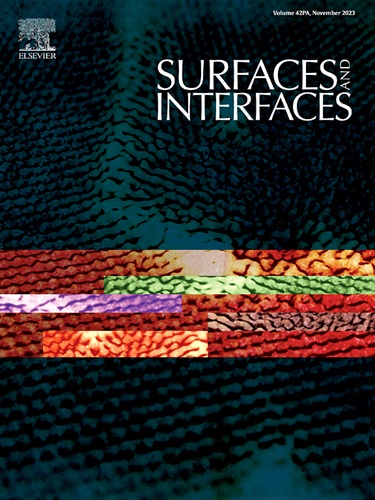Pechini synthesis and characterization of Ni3TiO5/NiTiO3 nanocomposites and their application as nano-photocatalyst for degradation of water-soluble organic pollutants under visible light
IF 5.7
2区 材料科学
Q2 CHEMISTRY, PHYSICAL
引用次数: 0
Abstract
The synthesis, structural characterization, and photocatalytic activity of Ni3TiO5/NiTiO3 nanocomposites at different experimental parameters are explored in this work. X-ray diffraction (XRD) was used to characterize the samples at 900 °C (the optimized temperature) developed using different precursors (molar ratio of Ni: Ti = 0.75:1) confirmed the prevalence of well-crystallized Ni3TiO5 (tetragonal structure) and NiTiO3 (rhombohedral structure). FTIR measurements confirmed the formation of characteristic metal–oxygen bonds associated with Ni3TiO5 and NiTiO3, whereas FESEM and TEM analyses revealed an optimal particle morphology with low aggregation. Under visible light illumination, the nanocomposite showed a notable photocatalytic performance of 86.78 % of malachite green (MG) degraded at neutral pH and 97.25 % under alkaline conditions. Kinetic analysis showed pseudo-first-order reaction behavior, with the highest rate constant (k = 0.03727 min⁻¹) at alkaline pH. Degradation of organic pollutants was mainly caused by hydroxyl radicals and photogenerated holes, and dye concentration, catalyst dosage, and reactive oxygen species had a specific influence on the photodecomposition efficiency. Treated material was tested for reusability, with the efficiency reduced only by about 8.55 % to just 78.23 % after five cycles, reflecting relatively good stability. Ni3TiO5/NiTiO3 exhibited excellent catalytic activity compared with other similar photocatalysts. These findings highlight the potential of the nanocomposite for practical application in wastewater treatment.

Ni3TiO5/NiTiO3纳米复合材料的合成与表征及其在可见光下作为降解水溶性有机污染物纳米光催化剂的应用
研究了不同实验参数下Ni3TiO5/NiTiO3纳米复合材料的合成、结构表征及其光催化活性。采用不同前驱体(Ni: Ti摩尔比= 0.75:1)制备的样品在900℃(优化温度)下进行了x射线衍射(XRD)表征,证实了Ni3TiO5(四方结构)和NiTiO3(菱形体结构)结晶良好。FTIR测试证实了Ni3TiO5和NiTiO3的特征金属-氧键的形成,而FESEM和TEM分析显示了低聚集的最佳颗粒形态。在可见光照射下,该纳米复合材料表现出显著的光催化性能,中性条件下孔雀石绿(MG)降解率为86.78%,碱性条件下降解率为97.25%。动力学分析显示出准一级反应行为,在碱性条件下反应速率常数k = 0.03727 min⁻¹。有机污染物的降解主要是由羟基自由基和光生空穴引起的,染料浓度、催化剂用量和活性氧种类对其降解效率有特定的影响。经过处理的材料进行了可重复使用性测试,经过5次循环后,效率仅降低了约8.55%,仅为78.23%,反映出相对较好的稳定性。与其他同类光催化剂相比,Ni3TiO5/NiTiO3具有优异的催化活性。这些发现突出了纳米复合材料在废水处理中的实际应用潜力。
本文章由计算机程序翻译,如有差异,请以英文原文为准。
求助全文
约1分钟内获得全文
求助全文
来源期刊

Surfaces and Interfaces
Chemistry-General Chemistry
CiteScore
8.50
自引率
6.50%
发文量
753
审稿时长
35 days
期刊介绍:
The aim of the journal is to provide a respectful outlet for ''sound science'' papers in all research areas on surfaces and interfaces. We define sound science papers as papers that describe new and well-executed research, but that do not necessarily provide brand new insights or are merely a description of research results.
Surfaces and Interfaces publishes research papers in all fields of surface science which may not always find the right home on first submission to our Elsevier sister journals (Applied Surface, Surface and Coatings Technology, Thin Solid Films)
 求助内容:
求助内容: 应助结果提醒方式:
应助结果提醒方式:


